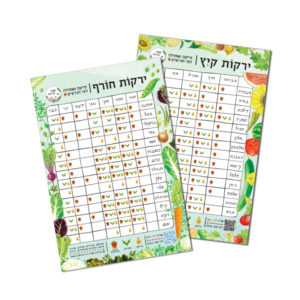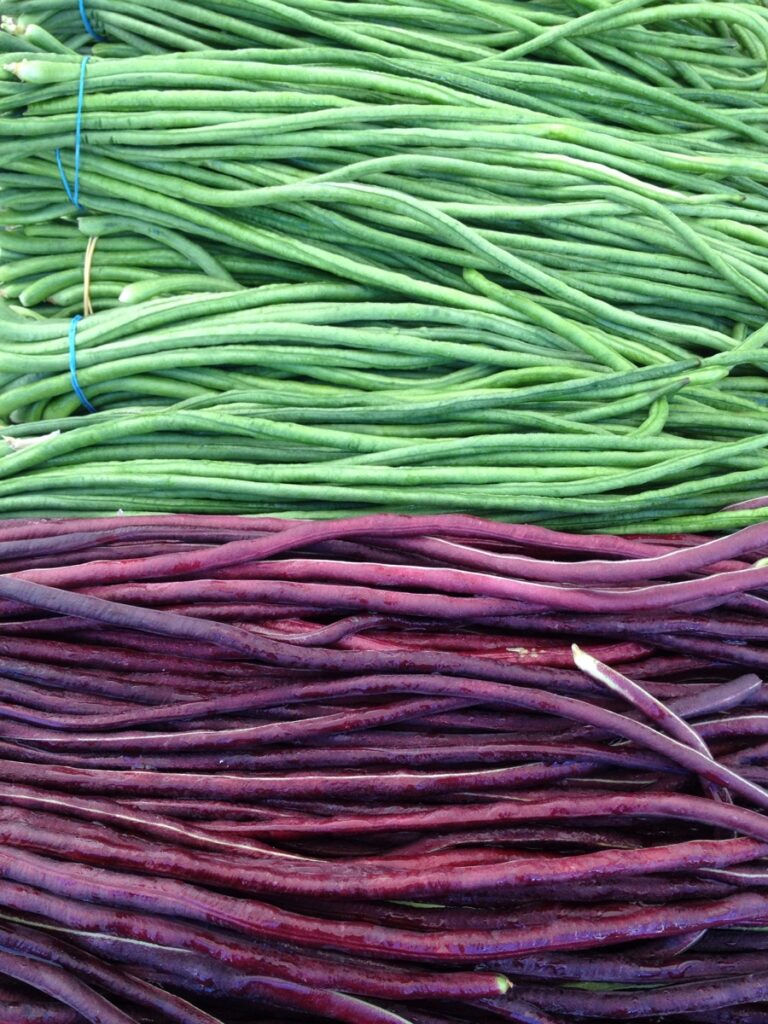The Shana Bagina (A Year in the Garden) calendar and weekly journal created annually by Ilana Stein, artist and gatherer, walk you through the direct connection between seasons and local agriculture and gathering. They serve as a unique, detailed guide to domestic Israeli gardening and nature, accompanied by beautiful illustrations, tips for home gardening and seasonal vegan recipes.
The focus of the newest (sixth!) edition, “Thinking Global, Eating Local,” is dedicated to our amazing local vegetation. Now is the time to get acquainted with the nutritious local plants in our surroundings, and to enjoy their availability and nutritional value.
A Year in the Garden products include a hanging/tabletop calendar, a weekly journal, and magnets with seeding schedules. Take a peek at the beautiful charm of Ilana’s calendar right here
Prices: Hanging/tabletop calendar: 75 NIS Weekly journal – 85 NIS Pair of magnets: 27 NIS (prices reduced for purchases in quantity)
A beautiful and distinctive gift for your loved ones (yourselves included…). Add these stunning calendars to your order via our order system.
______________________________________________
It’s a Yard-Long Road…
Said Rabbi Yona: “How did beans get their name? They amuse the heart and tickle the intestines.” — Yerushalmi Talmud
Over the past weeks, Chubeza’s Thai lubia has been ripening in abundant quantities, making a formal announcement that summer is at its peak. If you’ve been wondering why the latest green beans you’ve been receiving are so lengthy and coarse, well, it’s because they’re not green beans but rather… Thai lubia (yard-long beans) which arrive “gift-wrapped” in your boxes. They are indeed a present, albeit rather strange and unique. But don’t expect them to be green beans, because they simply are not…
The Thai bean/lubia (V. unguiculata ssp. Sesquipedalis) is a relative of the common bean, chickpea, soy, fava bean and other members of the Faboideae family we so love to nibble. Like them, the Thai lubia wears two outfits: the green cloak, eaten in long green pods, and the dry attire where only the dry seeds are consumed.
The ancient bean that grew in the Land of Israel is, in fact, the cowpea. At the time of the Mishna, the common (fresh/dry) bean was still mainly found in South America and not yet known in our area, while the cowpea, which probably originated in Africa, was the most prevalent.
When Rabbi Yona says that the bean (shu’it) is amusing (mesha’a’sha’at), he must mean “filling and satisfying.” The verb sha’ah in Aramaic connotes plaster, meaning “filling and covering.” The continuation of Rabbi Yona’s words refers to the other, less amusing part of the (dry) beans and cowpeas: their tendency to “tickle”, i.e., generate gas within, the intestines… Wordplay aside, the lubia was honored by our sages to merit a blessing at the Rosh Hashana table “to increase our merits and hearten us.”
For me, the amusement to the heart and tickling of the soul is reminiscent of the beauty and abundance they encompass – the bean plant is strong and beautiful, the gentle flowers resemble two butterflies fluttering between the leaves, and the green pods we pick are tasty, filling and heartwarming.
Both green beans and the cowpeas have fresh and dry versions, in a beautiful array of varieties. Even in our field, we host the green bean and its yellow sister in springtime, both of which grow on bushes alongside the yard-long bean, also known as the asparagus bean or Chinese long bean (and in Israel as the “Thai bean”), with black seeds, which grows upwards. We usually trellis it on either side of the pepper plants in order to stretch their shade nets along its polls.
The climbing and bush species apparently developed separately and in parallel by different farmers in different areas. The bushy species developed in Peru contain a gene that makes them grow in miniature form by limiting the number of branch segments, while turning the plant tissues (the branches and leaves) to reproductive tissues (flowers and pods). The explanation for this is that in Peru, the cornfields were limited, making a climbing-specie an additional burden on local farmers needing to support the climbing plants. (We definitely understand them, as we annually insert the poles into the ground and spread the nets for vining). This is why Peruvian farmers must have chosen to raise plants from seeds that grew in the form of a bush, and those were the species that developed there.
In Mexico, however, farmers chose to grow species that tended to crawl, since the bean grew near the corn that was used as a natural trellising pole, saving the farmer some extra work. The climbing beanpole was immortalized in the tale of Jack and the Beanstalk. Here, a poor boy climbs a huge beanstalk that he grew from magic seeds, embarking on a search for his identity which ultimately brings Jack happiness and wealth as he triumphs over evil. The bean’s tendency to climb brought it much respect in ancient American farming, as one of the “Three Sisters” crop combination. Archeologists have frequently found ancient Peruvian and Mexican farming sites with remnants of bean seeds together with those of corn and squash. The bean was seeded there together with the corn and squash, while the corn plants were used as trellising poles for the climbing bean. The squash covers the earth as a living mulch that serves to prevent weeds and water drainage, and the bean fixates nitrogen (see explanation below,) providing nutrients for both of her sisters:
Here are some explanations on how to prepare a bed like this one in your garden (and even in containers on your porch).
The bean is indeed magical in another sense – as a member of the legume family, it has many characteristics that help improve the earth. In a symbiotic process with a certain bacteria, it can fixate nitrogen from the atmosphere and store it in the earth in a form that is available to plants that grow with it or afterwards; its long roots grasp the earth and assist in preventing erosion, a feature that makes the bean very easy to grow, as it will cling to difficult and barren earth as well. In South America these qualities make the local plant “worth its weight in gold.”
The bean is seeded in Brazil, Nicaragua, Guatemala, Honduras and other places as a “cover crop” in small, local farms on rocky mountain slopes. The plants are cut and left in place while still green, and the next plants are planted in the organic matter (specifically corn). The result is a doubling and even tripling of the quantities of corn, and an improvement of the soil for years to come. Indeed, a magic bean!
Now let us focus just a bit on the lubia: In English, Thai lubia is known as the yard-long bean, bora bean, long-podded cowpea, asparagus bean, pea bean, snake bean, or Chinese long bean. All names relate to this bean’s various characteristics. It originates in Southeast Asia, hence the “Chinese” or “Thai” title, and can reach the hearty length of half a meter (though it’s generally harvested young, at approximately 30 cm. long and 1 cm thick). Lubia is similar to asparagus in diameter and length, and because of its flexibility may resemble a green snake (to those of you with overactive imaginations, at least). Its taste ranges between that of green beans and fresh green lubia, whilst the texture is less crunchy than the green bean and more flexible.
In its growth, lubia requires a great deal of heat and manages quite well throughout the sweltering months of summer (which certainly cannot be said of green beans who faint under the scorching sun). It is seeded in late spring, and we trellis it on poles with a net spread between the stalks on which the young plants climb adeptly and efficiently. Blooms appear within three months with butterfly-like flowers, and a pair of beans ripens from two flowers, adjacent to each other at the ends, like a couple of twin green worms:
Contrary to green beans, the lubia grows slowly and yields pods only after more than three months (compared to two or less). But this has its advantages – we can harvest the lubia on and on, till the temperatures drop in wintertime. These beans must be harvested with care, as the bloom pole continues to develop flowers throughout the season.
The Thai yard-long bean can be harvested, like at Chubeza, at a young stage at less than 30 cm long and 1 cm thick, and be used in the same way as one would prepare fresh lubia or green beans. You can also allow the pods to mature on the plant and use the black, red or white (depending on the variety) seeds as you would use dry lubia pods or any dry bean.
At Chubeza, we grow the green variety which bears black seeds, but in Asia there is a magnificent array of colorful, bountiful types. On the outside, the pods come in green and various violets while the seeds can be black, white, brown or red.
Thai yard-long beans can be used in recipes calling for green beans or fresh lubia, including soups, quiches and fresh salads. In China, it is lightly stir-fried, and is actually the original bean to have been used in stir-fried dishes. It tastes wonderful with fish and even pickled. The yard-long bean is rich in Vitamin A and contains a good amount of Vitamin C, iron, folic acid and dietary fibers.
Of course, green beans and lubia can be cooked, steamed, roasted, pickled, added to pasta, rice, salad and any vegetable stir. They most certainly add taste, color and a festive flair to your meal.
The lubia recipes featured on our website range from easy to more complex, and are all delicious, of course. But if you don’t feel like firing up a cooking flame in this scorching heat, just help yourself to a long snake bean and nibble away!
Our Thai workers are celebrating again this week, this time to mark the Mother Queen’s birthday. Congratulations to the queen and happy holiday to Tam, Hott, Montry, Vinay and Nopadol.
Enjoy a week full of summer abundance and a true feeling of vacation,
Alon, Bat-Ami, Dror, Orin and the entire Chubeza team
_______________________________________________
WHAT’S IN THIS WEEK’S BOXES?
Monday: Potatoes, lettuce, corn, lubia Thai yard-long beans/zucchini/okra, cucumbers, tomatoes, New Zealand spinach/basil, slice of pumpkin, parsley/coriander, eggplant, onions.
Large box, in addition: Butternut squash, cherry tomatoes, melon/bell peppers.
FRUIT BOXES: Plums, nectarines. Small box, in addition: Bananas, pears. Large box, in addition: Mango, grapes.
Wednesday: Potatoes, lettuce/basil, corn, lubia Thai yard-long beans/okra, cucumbers, tomatoes, bell peppers/zucchini, slice of pumpkin, parsley/coriander, eggplant, onions.
Large box, in addition: Butternut squash, cherry tomatoes, New Zealand spinach.
FRUIT BOXES: Plums, nectarines, grapes. Small box, in addition: Pears. Large box, in addition: Mango.









